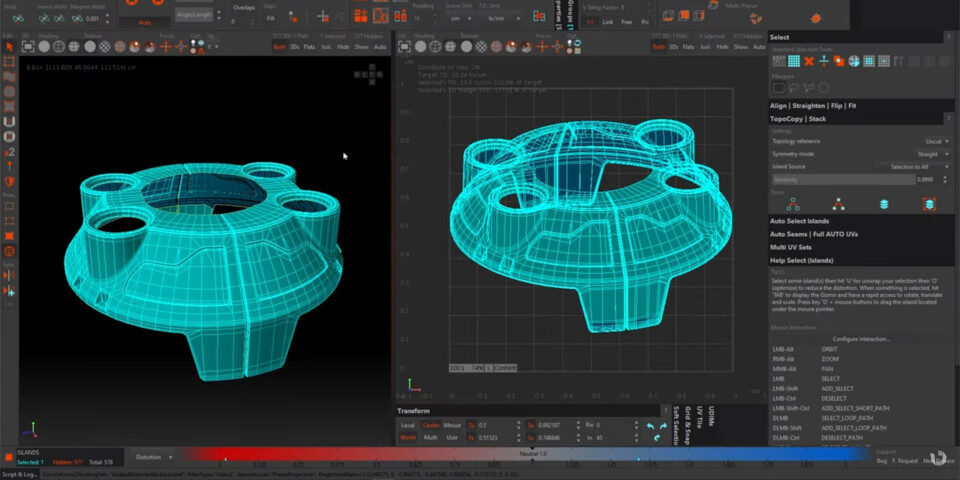Rizom-Lab ships RizomUV 2022.1 VS and RS
Rizom-Lab has released RizomUV 2022.1 Virtual Spaces (VS) and RizomUV 2022.1 Real Space (RS), the latest versions of its UV unwrapping applications.
The updates add planar UV projection, a new histogram display for selecting UV islands by size, Python 3 scripting, native support for Apple Silicon processors, and support for a wider range of Linux distros.
Standalone UV unwrapping tools for entertainment or product design work
Available under their current branding since 2018, RizomUV VS and RS are standalone applications for UV unwrapping 3D models and packing the resulting UV islands.
The two editions have similar features, but whereas VS is designed for games and VFX, RS is designed for product design, and works in unnormalised UV space, respecting the dimensions of the original model.

New Planar Projections system for projecting UVs onto a model
The main new feature in RizomUV 2022.1 is the new Planar Projections sytem.
It works in a similar way to planar texture projection in other DCC applications, projecting UVs onto a model from any of the world space axes, or from the orientation of the viewport, or from a custom plane.
It’s easier to see than describe: you can see the workflow at 00:30 in the video at the top of the story
New histogram mode to select UV islands by size, plus a reworked Polygon Magic Wand tool
Other new features include the option to display UV islands as a histogram based on island size, which also provides a quick way to select islands within a given size range.
The Polygon Magic Wand tool has been redesigned to make it more intuitive to use, with selection angle now based on the model’s surface normals by default.
The 3D viewport also now displays models with their embedded normals, meaning that smoothly curved surfaces now display correctly, rather than appearing faceted.
Workflow improvements include the option to lock groups of UV islands or UV tiles; to display poly counts only for selected or hidden face of a models; and to customise more properties via the Preferences dialog.
Support for Python 3 and better support for macOS and Linux
Under the hood, there have been a number of changes intended to make it easier to integrate RizomUV into production pipelines, and to increase performance across a range of platforms.
One key change is support for Python 3 – now specified by the VFX Reference Platform – for scripting, rather than Lua.
In addition, the macOS edition is now a universal binary, meaning that it supports Apple Silicon processors natively, while the Linux edition is compatible with “a wider range of distributions including CentOS 7.5”.
Pricing and system requirements
RizomUV 2022.1 VS and RS are available for 64-bit Windows 7+, macOS 10.12.5+ and Linux. There are integration plugins for 3ds Max, Blender and Modo, and legacy plugins for Cinema 4D, Maya and ZBrush.
Licensing varies between Indie users – artists and companies earning under €100,000/year – and Pro users.
Indie users get the option to rent to own or buy a perpetual licence; Pro users get a rental-only model. Indie licences of both types are node-locked to two computers, while Pro users can also rent floating licences.
For RizomUV VS, a perpetual licence costs €149.90 (around $150) and rent-to-own costs €14.90/month ($15/month). Pro licences cost €34.90/month ($35/month).
For RizomUV RS, a perpetual licence costs €300.00 (around $300) and rent-to-own costs €29.90/month ($30/month). Pro licences cost €59.90/month ($60/month).
Read an overview of the new features in RizomUV 2022.1 on Rizom-Lab’s website
Read a full list of new features in Rizom UV 2022 in the online changelog
